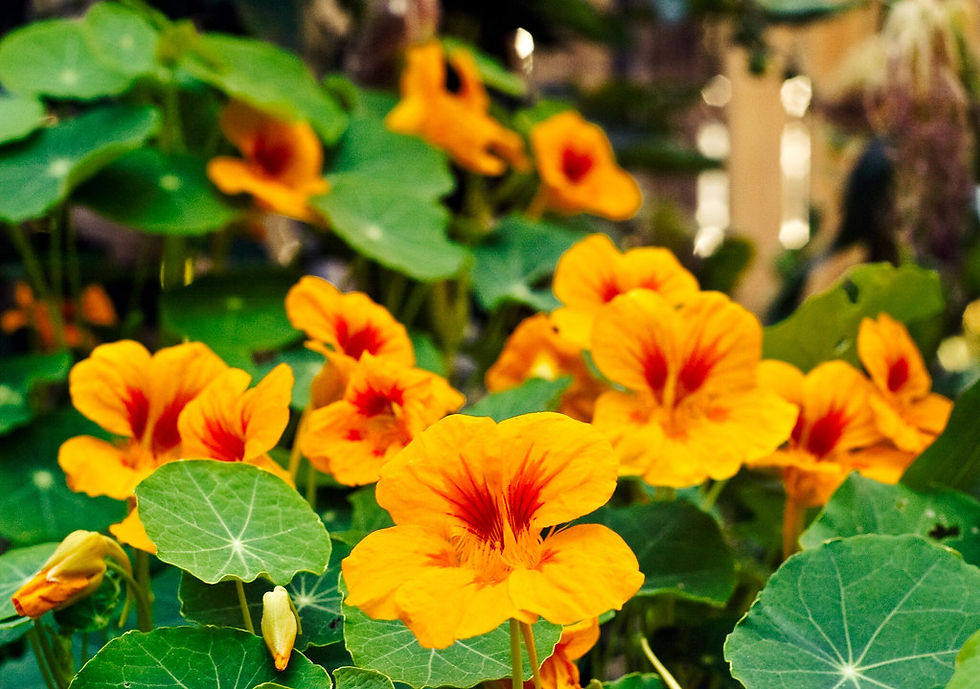Beyond the Bloom: The Surprising Benefits of Growing Nasturtiums
- Eutierria Essence
- Mar 20
- 3 min read
When it comes to beauty, function, and sheer versatility in the garden, few plants can compete with nasturtiums (Tropaeolum spp.). With their jewel-toned blooms, sprawling vines, and peppery edible leaves, these easy-to-grow flowers are a must-have for both beginner and experienced gardeners alike. But beyond their eye-catching appeal, nasturtiums offer a surprising range of benefits—from pest control and companion planting to culinary and medicinal uses. Let’s dive into the magical world of nasturtiums and uncover why you should absolutely be growing them in your garden!

A Garden Gem That Thrives on Neglect
One of the most delightful things about nasturtiums is their low-maintenance nature. These hardy plants flourish in poor soil, full sun, and minimal watering, making them perfect for beginner gardeners or those who love a set-it-and-forget-it approach. Overly rich soil? They’ll grow lush foliage at the expense of flowers. Too much water? They’ll sulk. But give them neglected, well-drained soil and plenty of sun, and they will reward you with dazzling blooms all season long.

🌞 Sun: Full sun (6–8 hours daily) for best flowering.
🌱 Soil: Well-drained, moderately dry, and not too fertile.
💧 Water: Minimal—about 1 inch per week, letting the soil dry between watering.
🌡️ Climate: Best in mild, warm temperatures (70°F is ideal). While they tolerate light frost, they won’t survive hard freezes.
The Ultimate Pest Magnet (In a Good Way!)
If you’re battling aphids, squash bugs, or whiteflies in your garden, nasturtiums might just be the organic pest control solution you need! These plants act as “trap crops”, luring harmful insects away from your prized vegetables. Aphids, for example, prefer nasturtiums over tomatoes or peppers, meaning they’ll flock to your nasturtium patch instead. All you have to do is hose them off or let beneficial insects, like ladybugs, take care of the rest.
Pests they attract (to distract from your veggies): Aphids, flea beetles, blackflies.
Pests they repel: Whiteflies, squash bugs, cucumber beetles, cabbage loopers.
Pollinator-friendly: Bees, butterflies, and hummingbirds love their nectar-rich blooms!
Companion Planting Magic
Nasturtiums don’t just look pretty—they’re also fantastic team players in the garden! Plant them alongside your veggies and watch as they improve the health and yield of nearby crops. Here’s why:
Brassicas (Cabbage, Kale, Broccoli) – Repels cabbage worms and aphids.
Cucumbers, Squash & Melons – Shields against squash bugs and cucumber beetles.
Tomatoes & Peppers – Acts as an aphid magnet (keeps aphids away from your nightshades).
Beans & Peas – Creates a mini eco-system by fixing nitrogen and keeping pests at bay.
🚫 Avoid planting with: Mint or overly aggressive vines like pumpkins, which can smother nasturtiums.
Edible & Delicious – A Peppery Treat!
If you love fresh garden flavors, nasturtiums are a culinary delight! Every part of the plant is edible, bringing a unique spicy, mustard-like kick to your dishes.

🌸 Flowers: Toss the vibrant blossoms in salads, top sandwiches, or even infuse them into vinegars.
🌿 Leaves: Add to salads, blend into pesto, or use as a fresh garnish.
🌱 Seed Pods: Pickle them as a budget-friendly substitute for capers.
🥔 Tubers (from Tropaeolum tuberosum): A lesser-known Andean delicacy with a radish-like bite.
💡 Fun fact: Nasturtium flowers have more Vitamin C than parsley and contain lutein, an antioxidant great for eye health!
History & Fun Facts
🌎 Ancient Treasure: Spanish explorers brought nasturtiums from South America to Europe in the 1500s, where they quickly became garden staples.
🎨 Monet’s Favorite: The famous painter Claude Monet lined the walkways of his garden at Giverny with nasturtiums, creating a stunning floral cascade.
⚓ Sailor’s Superfood: Because nasturtiums are rich in Vitamin C, they were used to prevent scurvy among sailors during long sea voyages.
🌿 Waterproof Leaves: Their leaves repel water like a lotus leaf! Try pouring water on one and watch droplets roll off like mercury!

Ready to Grow Your Own?
If you haven’t already added nasturtiums to your garden, what are you waiting for? Whether you want to repel pests, attract pollinators, liven up your meals, or simply add a pop of color, nasturtiums are one of the easiest, most rewarding plants you can grow.
Try planting a few different varieties, from trailing climbers to compact bush types, and experiment with their edible delights in the kitchen. One thing’s for sure: once you grow nasturtiums, you’ll never want a garden without them again! 🌱✨
What do you love most about nasturtiums? Share your gardening experiences in the comments below! 🌼👇




Comments